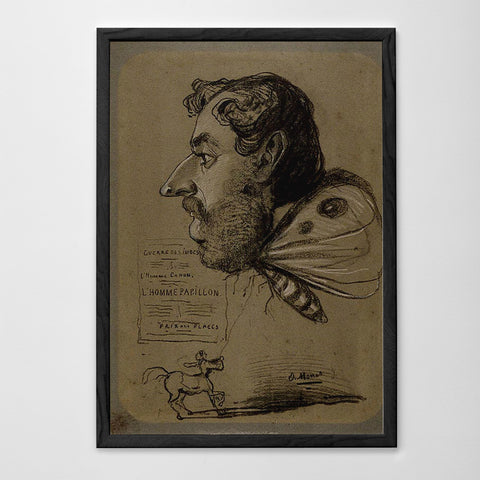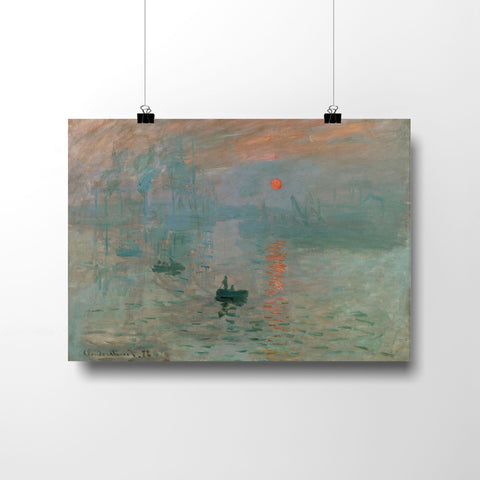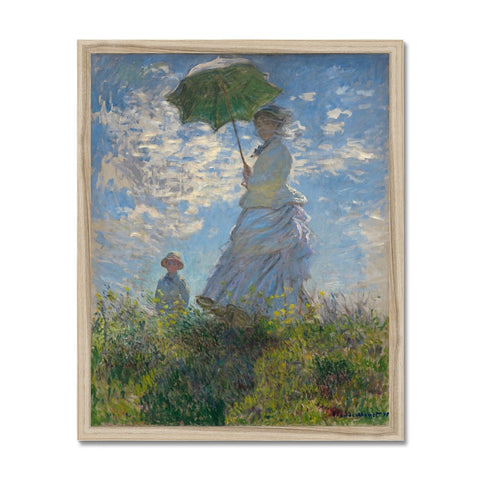9 Things Which Will Surprise You About Claude Monet.
1. Before becoming a painter, he was a popular caricaturist.
By the age of 14, Monet had made a name for himself with his charcoal caricatures of various Le Havre locals. The pieces, which he sold for 10-20 francs each. It was such a good living he refused to meet the artist Eugène Boudin who wanted to instruct him in the use of oils to paint landscapes, thankfully for us he eventually conceded and studied under his mentor. Monet later acknowledged: “If I have become a painter, it is entirely due to Eugène Boudin.”

2. Like so many great artists, his father encouraged him to give up painting. He was drafted into military service and spent a year in Algeria as his father thought it would “set him straight”.
In 1861, at the age of twenty, Monet was drafted into the First Regiment of African Light Cavalry. His father, despite having the means, declined to purchase the 2,500 franc exemption from conscription when Monet refused to give up painting. Although his time as a conscript in Algiers would influence his work “the impressions of light and colour that I received there…contained the germ of my future researches.”
3. In 1868, Monet attempted to drown himself in the Seine.
Shortly after the birth of his first son, Monet and his family were living in poverty; his father did not approve of his relationship and career and had cut him off financially. Struggling to support his family and frustrated by the French art establishment, Monet attempted suicide by jumping off of a bridge into the Seine River. Monet would continue to struggle with bouts of depression throughout his life.
4. Disillusioned with the elitism and strict rules within the salon system, Monet and others founded the Impressionist movement…
In 1862, Monet entered the studio of the Swiss painter Charles Gleyre. Alongside like-minded artists Pierre-Auguste Renoir, Frédéric Bazille and Alfred Sisley, he began to refine his visual language and technique. In 1874, Monet and others whose works were often rejected at the conservative Salon de Paris (including Renoir, Manet, Degas, Cézanne and Camille Pissarro) formed the Anonymous Society of Painters, Sculptors, and Engravers and organized an independent exhibition. It would later become known as The First Impressionist Exhibition.
5. …Which derives its name from Monet’s Impression, Sunrise.
Displayed at the 1874 exhibition, the painting depicts a hazy scene at the port of Le Havre. The critic Louis Leroy disparagingly referred to the painting as “Impressionistic”, commenting that “Wallpaper in its embryonic state is more laboured than this seascape!” The term, however, was soon enthusiastically embraced by the budding movement.

6. His own harshest critic, Monet destroyed as many as 500 of his own paintings.
In 1908, a show of his work in Paris had to be postponed after he took a knife to at least 15 of his water lily canvases. This was not his first bout of destruction, nor would it be his last; after his cataract surgery, he disposed of or reworked many of the paintings that were created at the height of his vision loss. His friend and former French Prime Minister Georges Clémenceau told a journalist in 1927, “Monet would attack his canvases when he was angry. And his anger was born of a dissatisfaction with his work…Monet destroyed canvases in his quest for perfection.”
7. His favourite model was his first wife Camille Monet (née Doncieux), who appears in over 30 of his paintings.
The two met in 1865 and were married in 1870. Doncieux, who also modelled for Renoir and Manet, is featured in numerous works including the 1866 painting Camille (The Woman in the Green Dress), and Women in the Garden (1866-67), for which she posed for all four figures. Shortly after the birth of their second child, Camille tragically died at the age of 32, probably from pelvic cancer. A grieving Monet painted her for the last time in Camille Monet on her deathbed (1879). The art critic John Berger described the painting as “a terrible blizzard of loss…there can be very few death-bed paintings which have been so intensely felt or subjectively expressive.”

Woman with a Parasol - Madame Monet and Her Son by Claude Monet features his first wife Camille Monet. Museum quality prints are available here.
8. His second wife, Alice Hoschedé, destroyed almost all photographic records of Camille.
Alice and her then-husband, Ernest Hoschedé, impoverished by debt, moved in with the Monets in 1878. Soon after Camille’s death, rumours began to swirl about Monet’s relationship with Hoschedé. They were eventually married in 1892 after the death of Hoschedé’s estranged husband. Alice was reportedly so jealous of Camille that she demanded that Monet destroy all photos, letters, and mementos of her. Only one photograph is known to have survived, an 1871 portrait that was kept in a private collection.
9. Fascinated by the effects of atmosphere on light and colour, Monet created many studies of the same subject observed under different conditions.
Monet produced numerous series examining the effects of the time of day, seasons, and weather conditions. These include the Haystacks series of 1890-91, the famous Rouen Cathedral paintings of 1892-94, and the over 250 Water Lilies that Monet painted in the last decades of his life. His series paintings diverge from his earlier and more spontaneous work in their careful and deliberate creation. Pop Art and Minimalism are both influenced by Monet’s pioneering interest in the serial display of objects.
How many of these did you already know?
